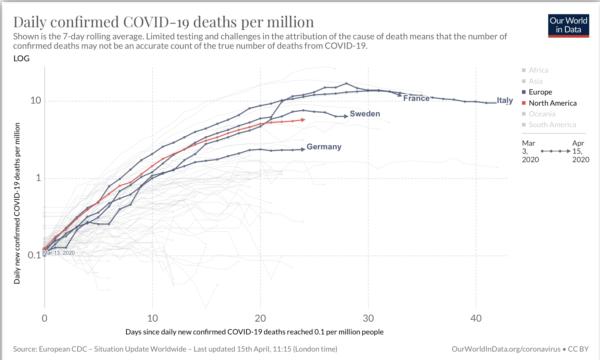• Don’t look now, but it seems China’s mendacious deception is not limited to concealing disease vectors. From the Wall Street Journal early this afternoon:
China might be secretly conducting nuclear tests with very low explosive power despite Beijing’s assertions that it is strictly adhering to an international accord banning all nuclear tests, according to a new arms-control report to be made public by the State Department. . .
The concerns stem from the high tempo of activity at China’s Lop Nur test site, extensive excavations at the site, and Beijing’s purported use of special chambers to contain explosions. Another factor feeding U.S. suspicions is the interruption in past years of data transmissions from monitoring stations on Chinese territory that are designed to detect radioactive emissions and seismic tremors.
To keep up with all things China, bookmark the Committee on the Present Danger/China. Their hour has come.
• One of the thing I hope will come out of the current mess is a heightened skepticism of data charts (especially climate change charts). We’re awash right now in conflicting data charts about COVID-19 owing to the usual two problems: incomplete or incorrect data, and corrupting assumptions in models. Of course, I’m sure this just never happens in the climate change domain.
That said, one of my favorite data analysis sources is Our World in Data, run by Max Roser at Oxford University. A lot of the data analysis coming from the site illustrates the extraordinary human progress in recent decades all around the world, showing how in most ways, the world is getting better and better all the time. Naturally, this infuriates the Malthusian left, who hate human progress with the intensity of a thousand white-hot desert solar panels.
Max and his team are all over tracking COVID-19, and one of the things I like about their approach is that every chart includes this disclaimer: “Limited testing and challenges in the attribution of the cause of death means that the number of confirmed deaths may not be an accurate count of the true number of deaths from COVID-19.” I encourage interested readers to check out their interactive slide-deck, where you can customize a data analysis by checking off individual countries. I did this one, which shows the death-rate-per-million population, highlighting a few countries including the U.S. (the tan line) and Sweden. We keep being told that Sweden is a disaster—or will be a disaster—because they aren’t shutting down their economy and locking people in. This chart clearly shows that the death rate in Sweden is not much different than the U.S. (where we may be over-attributing COVID-19 deaths, as has been argued).

• This interesting pre-print paper at MedRxIv, “Indoor Transmission of SARS-CoV-2,” ratifies the common sense conclusion that the risk of outdoor transmission can’t justify the extreme lockdowns of parks, tennis courts, etc. Here’s the abstract, highlighted:
By early April 2020, the COVID-19 pandemic had infected nearly one million people and had spread to nearly all countries worldwide. It is essential to understand where and how SARS-CoV-2 is transmitted. Methods: Case reports were extracted from the local Municipal Health Commissions of 320 prefectural cities (municipalities) in China, not including Hubei province, between 4 January and 11 February 2020. We identified all outbreaks involving three or more cases and reviewed the major characteristics of the enclosed spaces in which the outbreaks were reported and associated indoor environmental issues. Results: Three hundred and eighteen outbreaks with three or more cases were identified, involving 1245 confirmed cases in 120 prefectural cities. We divided the venues in which the outbreaks occurred into six categories: homes, transport, food, entertainment, shopping, and miscellaneous. Among the identified outbreaks, 53.8% involved three cases, 26.4% involved four cases, and only 1.6% involved ten or more cases. Home outbreaks were the dominant category (254 of 318 outbreaks; 79.9%), followed by transport (108; 34.0%; note that many outbreaks involved more than one venue category). Most home outbreaks involved three to five cases. We identified only a single outbreak in an outdoor environment, which involved two cases. Conclusions: All identified outbreaks of three or more cases occurred in an indoor environment, which confirms that sharing indoor space is a major SARS-CoV-2 infection risk.
Memo to Michigan Gov. Whitless: Planting seeds in your garden is one of the best things people can do right now as spring begins.
• Breaking: Germany will start re-opening its economy next week. From Barron’s:
Germany will begin easing restrictions on its economy Monday, April 20. German Chancellor Angela Merkel said stores smaller than 800 square meters (8,611 square feet) can open—assuming they take steps to “maintain hygiene.” Schools will start re-opening for class on May 4, but large events are banned until Aug 31.
Notice: All comments are subject to moderation. Our comments are intended to be a forum for civil discourse bearing on the subject under discussion. Commenters who stray beyond the bounds of civility or employ what we deem gratuitous vulgarity in a comment — including, but not limited to, “s***,” “f***,” “a*******,” or one of their many variants — will be banned without further notice in the sole discretion of the site moderator.